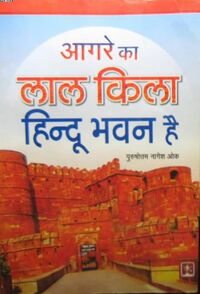Red Fort of Agra
For Red Fort in Delhi, please see Red Fort of Delhi

The Red Fort of Agra (popularly known as Agra Fort), is a UNESCO World Heritage site located in Agra city. The fort is also known as Lal Qila, Fort Rouge and Red Fort of Agra (आगरे का लाल किला). It is about 2.5 km northwest of its much more famous sister monument, the Taj Mahal. The fort can be more accurately described as a walled palatial city. Agra Fort was built by Akbar in Red sandstone when he was through with the consolidation of his power after accession to throne. Agra Fort worked both as a military strategic point as well as the royal residence.[1]
Ever since Babur defeated and killed Ibrahim Lodi at Panipat in 1526, Agra played an important center of Mughal Empire, it was in a ruined condition and Akbar decided to make it his capital and arrived in Agra in 1558. Akbar had it rebuilt with red sandstone. Architects laid the foundation and it was built with bricks in the inner core with sandstone on external surfaces. Some 1,444,000 builders worked on it for eight years, completing it in 1573.
Later, Akbar's grandson Shah Jahan (1627–1657), was imprisoned in the fort in his old age. Shah Jahan's son, Aurangzeb, had put him in one cell within the fort, from which Taj Mahal could be viewed. It is rumored that Shah Jahan died in Muasamman Burj, a tower with a marble balcony with an excellent view of the Taj Mahal.
Short overview
The fort contains splendid palaces both in red sandstone and white marble built by two generations (Akbar, and later Jehangir and Shahjahan. Of the nearly 500 Akbari buildings built in the Bengal and Gujarati traditions, only a few have survived, arrayed in a band on the riverfront. Some of the exquisite structures that deserve a mention are:
- Sheesh Mahal - Literally meaning 'Glass Palace' it was the royal dressing room adorned by tiny mirror-like glass-mosaic decorations on the walls.
- The Diwan-i-Aam - Which was used as a communications ground between the public and the aristocracy and once housed the Peacock Throne.
- Diwan-i-Khas - A hall of private audience, it was used to welcome kings and dignitaries.
- The Anguri Bagh - It houses 85 square, geometrically arranged lush gardens.
- Khas Mahal - An immaculate white marble palace.
- Mina Masjid - Literally meaning 'Heavenly Mosque', it is a tiny mosque closed to the public.
- Nagina Masjid - Literally meaning 'Gem Mosque', it was designed exclusively for the ladies of the court.
- Musamman Burj - A large, octagonal tower with a balcony facing the Taj Mahal.
Controversy about who built the fort

Historian P.N. Oak has opined that both the Red Fort at Agra, as well as Taj Mahal were built much earlier, by Indian kings, before the Mughal Sultanate started in India.
Agra Fort in Jat History
Capture of Agra Fort (12 June 1761)

Agra was the richest town during those. Maharaja Suraj Mal decided to capture Agra fort to re-establish his influence in doab region. On 3 may 1761 the Jat army of Suraj Mal with 4000 Jat soldiers reached Agra under the command of Balram Singh and gave the massage of Maharaja Suraj Mal to the kiledar (incharge) of Agra fort that the army wants to cross Jamuna and needs camping place. The kiledar gave the sanction for camping. Meanwhile the Jat army started entering the fort, which was resisted by the guards in which 200 people died. Jat army started war from Jamamasjid. During this period Maharaja Suraj Mal stayed at Mathura to observe the situations. On 24 May 1761 Maharaja Suraj Mal along with Imād and Gangadhar Tantya moved from Mathura, crossed Jamuna and reached Aligarh. From Aligarh his army moved and captured the areas of Jat ruler koīl and Jalesar. They reached Agra to help his army at Agra in the first week of June. Maharaja Suraj Mal arrested the family members of the guards staying in Agra town and pressurized the guards of fort for surrender. At last the kiledar agreed to surrender by receiving a bribe of Rs 1 lakh and jagir of five villages. Thus after a seize of one month Maharaja Suraj Mal captured Agra Fort on 12 June 1761 and it remained in the possession of Bharatpur rulers till 1774. [2]
After Maharaja Suraj Mal, Maharaja Jawahar Singh, Maharaja Ratan Singh and Maharaja Kehri Singh (minor) under residentship of Maharaja Nawal Singh ruled over Agra Fort. There is a haveli in the name Maharaja Nawal Singh in Agra Fort and also a Chhatri of Maharaja Jawahar Singh built in right-side of Khasmahal near the Chhatri of Rosanara-Jahanara.[3],[4]
External Links
- Agra Fort at UNESCO's website
- Agra Fort at the website of Archaeological Survey of India
- Brief History of Agra Fort - importantindia.com
- Web-page of National Informatics Center, Govt. of India, on Agra Fort
Author of this page
| Dayanand Deswal |
References
- ↑ http://agra.nic.in/historyofredfort.html
- ↑ Dr. Prakash Chandra Chandawat: Maharaja Suraj Mal aur unka yug, Jaypal Agencies Agra, 1982, Pages 197-200
- ↑ Agra Gazeteer 1884, page 620
- ↑ Jatbandhu Agra, 25 January 2005

